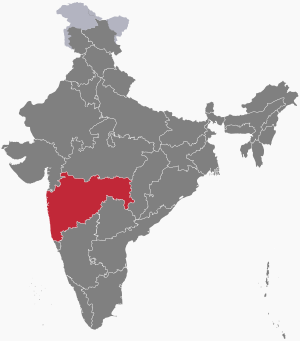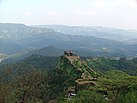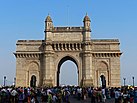Maharashtra | |
|---|---|
| State of Maharashtra | |
|
From top, left to right: Ajanta Caves, Kailasa Temple at Ellora Caves, Pratapgad Fort (near Mahabaleshwar) located in the Western Ghats, statue of Chatrapati outside Raigad fort, Shaniwar Wada, Hazur Sahib Nanded, Chhatrapati Shivaji Terminus, The Gateway of India | |
| Etymology: "mahā" (Great) and Sanskritized form of "Ratta dynasty" | |
| Nickname: "Gateway of India" | |
| Motto(s): Pratipaccandralēkhēva vardhiṣṇurviśva vanditā Mahārāṣṭrasya rājyasya mudrā bhadrāya rājatē (The glory of Maharashtra will grow like the first day moon. It will be worshipped by the world and will shine only for the well-being of people) | |
| Anthem: Jai Jai Mahārāṣṭra Mājhā[1] ("Victory to My Maharashtra!")[2] | |
 Location of Maharashtra in India | |
| Coordinates: 18°58′N 72°49′E / 18.97°N 72.82°E | |
| Country | India |
| Region | West India |
| Before was | State of Bombay (1950–1960) |
| Formation (by bifurcation) | 1 May 1960 |
| Capital | Mumbai Nagpur (winter) |
| Largest city | Mumbai |
| Largest metro | Mumbai Metropolitan Region |
| Districts | 36 (6 divisions) |
| Government | |
| • Body | Government of Maharashtra |
| • Governor | C. P. Radhakrishnan |
| • Chief minister | Eknath Shinde (SHS) |
| • Deputy chief minister | Devendra Fadnavis (BJP) Ajit Pawar (NCP) |
| State Legislature | Bicameral Maharashtra Legislature |
| • Council | Maharashtra Legislative Council (78 seats) |
| • Assembly | Maharashtra Legislative Assembly (288 seats) |
| National Parliament | Parliament of India |
| • Rajya Sabha | 19 seats |
| • Lok Sabha | 48 seats |
| High Court | Bombay High Court |
| Area | |
• Total | 307,713 km2 (118,809 sq mi) |
| • Rank | 3rd |
| Dimensions | |
| • Length | 870 km (540 mi) |
| • Width | 605 km (376 mi) |
| Elevation | 100 m (300 ft) |
| Highest elevation | 1,646 m (5,400 ft) |
| Lowest elevation | −1 m (−3 ft) |
| Population (2011)[5] | |
• Total | |
| • Rank | 2nd |
| • Density | 370/km2 (1,000/sq mi) |
| • Urban | 45.22% |
| • Rural | 54.78% |
| Demonym | Maharashtrian |
| Language | |
| • Official | Marathi[6][7] |
| • Official script | Devanagari script |
| GDP | |
| • Total (2024–25) | |
| • Rank | (1st) |
| • Per capita | |
| Time zone | UTC+05:30 (IST) |
| ISO 3166 code | IN-MH |
| Vehicle registration | MH |
| HDI (2022) | |
| Literacy (2017) | |
| Sex ratio (2021) | 966♀/1000 ♂[12] (23rd) |
| Website | maharashtra |
| Symbols of Maharashtra | |
 | |
| Song | Jai Jai Mahārāṣṭra Mājhā[1] ("Victory to My Maharashtra!")[2] |
| Foundation day | Maharashtra Day |
| Bird | Yellow-footed green pigeon[13] |
| Butterfly | Blue Mormon[14] |
| Fish | Silver Pomfret |
| Flower | Jarul[13][15] |
| Mammal | Indian giant squirrel[13] |
| Tree | Mango tree[13][16] |
| State highway mark | |
 | |
| State highway of Maharashtra MH SH1-MH SH368 | |
| List of Indian state symbols | |
| ^The State of Bombay was split into two States i.e. Maharashtra and Gujarat by the Bombay Reorganisation Act 1960[17] †† Common high court | |
Maharashtra (ISO: Mahārāṣṭra; Marathi: [məhaːɾaːʂʈɾə] ) is a state in the western peninsular region of India occupying a substantial portion of the Deccan Plateau. It is bordered by the Arabian Sea to the west, the Indian states of Karnataka and Goa to the south, Telangana to the southeast and Chhattisgarh to the east, Gujarat and Madhya Pradesh to the north, and the Indian union territory of Dadra and Nagar Haveli and Daman and Diu to the northwest.[18] Maharashtra is the second-most populous state in India.
The state is divided into 6 divisions and 36 districts, Mumbai, is the capital of Maharashtra due to its historical significance as a major trading port and its status as India's financial hub, housing key institutions and a diverse economy. Additionally, its well-developed infrastructure and cultural diversity make it a suitable administrative center for the state. the most populous urban area in India, and Nagpur serving as the winter capital.[19] The Godavari and Krishna are the state's two major rivers, and forests cover 16.47% of the state's geographical area. The state is home to six UNESCO World Heritage Sites: Ajanta Caves, Ellora Caves, Elephanta Caves, Chhatrapati Shivaji Terminus (formerly Victoria Terminus), the Victorian Gothic and Art Deco Ensembles of Mumbai and the Western Ghats, a heritage site made up of 39 individual properties of which 4 are in Maharashtra.[20][21]
The economy of Maharashtra is the largest in India, with a gross state domestic product (GSDP) of ₹42.5 trillion (US$510 billion) and GSDP per capita of ₹335,247 (US$4,000);[9] it is the single-largest contributor to India's economy, being accountable for 14% of all-India nominal GDP.[22][23][24] The service sector dominates the state's economy, accounting for 69.3% of the value of the output of the country. Although agriculture accounts for 12% of the state GDP, it employs nearly half the population of the state.
Maharashtra is one of the most industrialised states in India. The state's capital, Mumbai, is India's financial and commercial capital.[25] The Bombay Stock Exchange, India's largest stock exchange and the oldest in Asia, is located in the city, as is the National Stock Exchange, which is the second-largest stock exchange in India and one of world's largest derivatives exchanges. The state has played a significant role in the country's social and political life and is widely considered a leader in terms of agricultural and industrial production, trade and transport, and education.[26] Maharashtra is the ninth-highest ranking among Indian states in the human development index.[27]
The region that encompasses the modern state has a history going back many millennia. Notable dynasties that ruled the region include the Asmakas, the Mauryas, the Satavahanas, the Western Satraps, the Abhiras, the Vakatakas, the Chalukyas, the Rashtrakutas, the Western Chalukyas, the Seuna Yadavas, the Khaljis, the Tughlaqs, the Bahamanis and the Mughals. In the early nineteenth century, the region was divided between the Dominions of the Peshwa in the Maratha Confederacy and the Nizamate of Hyderabad.
After two wars and the proclamation of the Indian Empire, the region became a part of the Bombay Province, the Berar Province and the Central Provinces of India under direct British rule and the Deccan States Agency under Crown suzerainty. Between 1950 and 1956, the Bombay Province became the Bombay State in the Indian Union, and Berar, the Deccan states and the Gujarat states were merged into the Bombay State. Aspirations of a separate state for Marathi-speaking peoples were pursued by the United Maharashtra Movement; their advocacy eventually borne fruit on 1 May 1960, when the State of Bombay was bifurcated into the states of Maharasthra and Gujarat.
- ^ "Iconic 'Jai Jai Maharashtra Maza' proclaimed new State Song". 31 January 2023.
- ^ Jerry Pinto; Naresh Fernandes (2003). Bombay, Meri Jaan: Writings on Mumbai. Penguin Books. p. 237. ISBN 9780143029663.
- ^ "MAHARASHTRA SADAN NEW DELHI". Archived from the original on 18 June 2022. Retrieved 24 March 2023.
- ^ "Kalsubai". 22 July 2011. Archived from the original on 22 July 2011. Retrieved 24 March 2023.
- ^ "Area, population, decennial growth rate and density for 2001 and 2011 at a glance for Maharashtra and the districts: provisional population totals paper 1 of 2011: Maharashtra". Registrar General & Census Commissioner, India. Archived from the original on 7 January 2012. Retrieved 26 January 2012.
- ^ "The Maharashtra Official Languages Act, 1964; Amendment Act, 2015" (PDF). lawsofindia.org. Archived (PDF) from the original on 15 November 2017.
- ^ "Report of the Commissioner for linguistic minorities: 52nd report (July 2014 to June 2015)" (PDF). Commissioner for Linguistic Minorities, Ministry of Minority Affairs, Government of India. pp. 34–35. Archived from the original (PDF) on 28 December 2017. Retrieved 16 February 2016.
- ^ "Maharsatra GSDP likely to expand by 10% in FY 2024-25". The Economic Times. PTI. 1 March 2024. Archived from the original on 1 March 2024. Retrieved 1 March 2024.
- ^ a b "Economic Survey of Maharashtra 2022-23, Government of Maharashtra" (PDF). Government of Maharashtra. 1 February 2022. p. 21. Retrieved 1 February 2023.
- ^ "GDP Of Indian States And Union Territories". Forbes India. Archived from the original on 5 December 2023. Retrieved 28 November 2023.
- ^ "Sub-national HDI - Subnational HDI". Global Data Lab. 15 June 2021. Archived from the original on 8 February 2023. Retrieved 28 November 2023.
- ^ "Sex ratio of State and Union Territories of India as per National Health survey (2019-2021)". Ministry of Health and Family Welfare, India. Archived from the original on 8 January 2023. Retrieved 8 January 2023.
- ^ a b c d "State Animal, Bird, Tree and Flower". Panna Tiger Reserve. Archived from the original on 13 October 2014. Retrieved 29 August 2014.
- ^ "State Mammal Blue Mormon :: Maharashtra". The Hindu. 22 June 2015. Archived from the original on 18 November 2022. Retrieved 18 November 2022.
- ^ "State Flower Jarul: Maharashtra". city flowers. 11 March 2021. Archived from the original on 30 September 2017. Retrieved 18 November 2022.
- ^ Dinesh Valke. "Official Flora of States and Union Territories of India". flowers of india. Archived from the original on 18 November 2022. Retrieved 18 November 2022.
- ^ Ministry of Law, Government of India (1960). The Bombay Reorganisation Act 1960. Archived from the original on 1 January 2016. Retrieved 23 May 2015.
- ^ "Maharashtra Tourism". Archived from the original on 18 January 2019. Retrieved 3 February 2019.
- ^ Bhushan Kale (10 December 2014). "उपराजधानी ते राजधानी 'शिवनेरी'ची सवारी" [Uparājdhānī tē Rājdhānī' śivanērī'cī Savārī]. Divya Marathi (in Marathi). Nagpur, Maharashtra, India. Archived from the original on 23 June 2015. Retrieved 23 May 2015.
- ^ "India". UNESCO World Heritage Centre. Archived from the original on 17 February 2023. Retrieved 19 March 2023.
- ^ "Western Ghats". UNESCO World Heritage Centre. Archived from the original on 5 October 2022. Retrieved 19 March 2023.
- ^ —Prabhu, K. Seeta; Sarker, P.C. (5 September 1992), "Identification of Levels of Development: Case of Maharashtra", Economic and Political Weekly, 26 (36): 1927–1937, ISSN 0012-9976, JSTOR 4398849
—Pletcher, Kenneth (1 April 2010). The Geography of India: Sacred and Historic Places Understanding India. Britannica Educational Publishing. p. 283. ISBN 978-1-615-30202-4. Retrieved 11 July 2020.
—Sundar, K.R. Shyam (2009). "Current State and Evolution of Industrial Relations in Maharashtra". International Labour Organization. Cornell University: 8–30. Archived from the original on 18 March 2020. Retrieved 8 July 2020.
—"Maharashtra's 2025 agenda: Why state's $1 trillion GDP target could make it India's growth engine". Financial Express. Archived from the original on 24 June 2018. Retrieved 25 June 2018. - ^ Biswas, Soutik (17 May 2023). "Maharashtra, India's richest state". BBC. Archived from the original on 17 May 2023. Retrieved 19 May 2023.
- ^ "India's richest province of Maharashtra is the nation's best performer". Bloomberg.
- ^ —Planning Commission of the Government of India (2007). Maharashtra, Development Report. Academic Foundation. p. 407. ISBN 978-8-171-88540-4.
—Bhandari Laveesh (2009). Indian States at a Glance 2008-09: Performance, Facts And Figures – Maharashtra. Pearson Education India. p. 176. ISBN 978-8-131-72343-2. - ^ —Pletcher, Kenneth (1 April 2010). The Geography of India: Sacred and Historic Places Understanding India. Britannica Educational Publishing. p. 280. ISBN 978-1-615-30202-4. Retrieved 11 July 2020.
—Mookerjee, Sitanshu; Wanmali, Sudhir Vyankatesh, "Maharashtra", Encyclopædia Britannica, archived from the original on 28 June 2020, retrieved 4 July 2020,Maharashtra is one of India's biggest commercial and industrial centres, and it has played a significant role in the country's social and political life. Maharashtra is a leader among Indian states in terms of agricultural and industrial production, trade and transport, and education.
—Sundar, K.R. Shyam (2009). "Current State and Evolution of Industrial Relations in Maharashtra". International Labour Organization. Cornell University: 8–70. Archived from the original on 18 March 2020. Retrieved 8 July 2020. - ^ "HDI: How States Fare in Human Development". Centre for Economic Data & Analysis. 23 January 2023. Archived from the original on 23 September 2018. Retrieved 14 June 2021.








